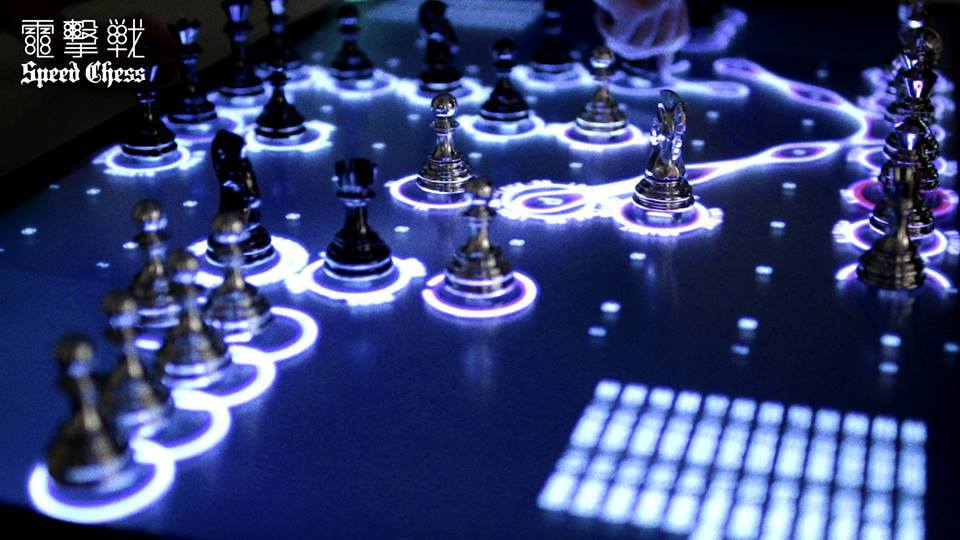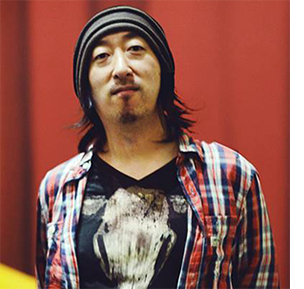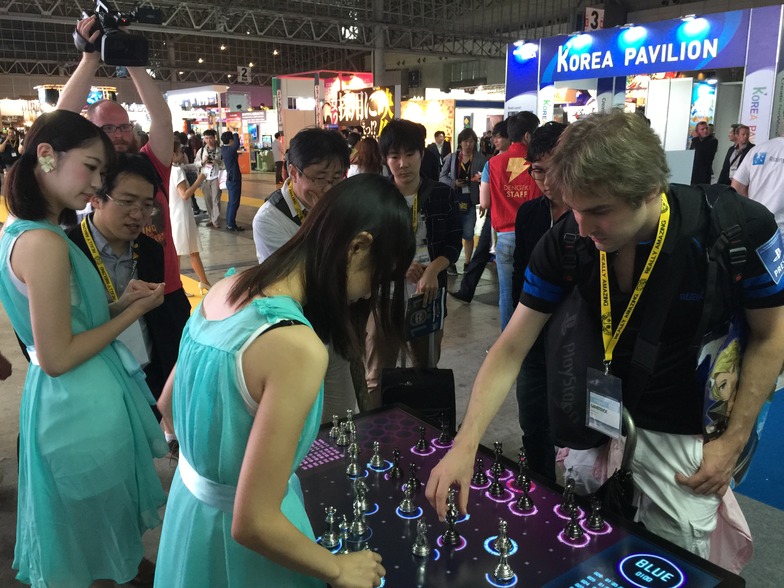Note: This website was automatically translated, so some terms or nuances may not be completely accurate.
Updating the world's oldest board game (chess) with the power of technology
Hello. I'm Kaga, writing the second installment of this series.
This time, I'd like to introduce a game product we decided to prototype on our own: "Blitz War -Speed Chess-".

What is "Blitz War -Speed Chess-"?
"Blitz War -Speed Chess-" is a project developed with Nobuo Harano of VASQUEL and Hiroyuki Mikami of SALVO, aiming to update chess—one of the world's oldest board games—through technology. By combining electrically conductive pieces with a touchscreen chessboard, the pieces themselves gain a time dimension, eliminating the turn-based system that forms the core of the rules. Unlike traditional chess, where players take turns after careful deliberation, two players move their pieces rapidly in real-time, relentlessly pursuing the opponent's king. This evolved version of chess offers thrilling, fast-paced gameplay that demands split-second decision-making and reflexes, complementing its traditional strategic depth.
Project Origins: Advertising Industry and Prototyping
The advertising industry fundamentally operates on a custom-order production style, progressing by meticulously building consensus starting from client briefings. Among advertising agencies, especially those without in-house production capabilities, the "prototyping" approach might seem particularly unfamiliar. I used to think that way.
However, now that we're increasingly expected to break free from traditional advertising frameworks and deliver solution-driven, diverse proposals leading to unprecedented service and product development, I'm starting to strongly feel the necessity of this methodology. When venturing beyond advertising, we tend to fall into a passive stance of "having ideas but lacking opportunities to materialize them." We desperately lack experience in the hands-on process of quickly shaping vague mental images into tangible forms, then refining them through trial and error. This deficiency could prove fatal...
Driven by this sense of urgency, we boldly created "Blitzkrieg -Speed Chess-".
Lightning War was actually a project I'd been conceptualizing for several years. I'd been eagerly waiting for an opportunity to pitch it to clients, but it never materialized and ended up shelved. Instead of letting it fade into obscurity, we pooled the necessary resources from each company (Dentsu Inc.: Planning & Production, Basquille: Creative & Experience Design, Salvo: Game Development) to first develop an app-based prototype. Using that prototype as a foundation, we recruited partner companies like 3M (technical cooperation for touch panel displays) and Sea Force (production of original chess pieces), ultimately arriving at its current form.
The Challenge of Updating a Classic Format
We strongly believe in the potential of using technology to update the classic game format underlying this project. While technology often deepens or enriches entertainment experiences like games, it can also raise the barrier to entry and narrow the audience.
We believe that by leveraging the "classic format = a foundation that many people can enjoy," and directing technology to remove existing rules and constraints, we can create a future of play with a broad base that anyone can easily enjoy.
Indeed, as mentioned earlier, Blitz Chess achieves a more exciting gameplay experience by using electrically conductive pieces and a touchscreen chessboard to eliminate the turn-based system at the core of the rules. It also imposes time limits on re-moving pieces once they've been moved. Furthermore, features like displaying possible moves on the board when a piece is touched make it intuitively enjoyable even without knowing chess rules.
"Why Chess?"
This question was frequently asked when we first unveiled the project. When we first conceived the idea of removing turn-based mechanics from board games, creating an entirely new game did briefly cross our minds. However, a new game would require players to learn its rules from scratch. Therefore, we prioritized accessibility above all else. We aimed to create novelty by transforming something familiar, leading us to choose chess as our motif—a game known worldwide with an estimated 700 million players. Shogi was actually a candidate too. However, since even Japanese players can somewhat understand chess as an extension of shogi, and because we wanted gameplay that emphasized physical sensation, we ultimately chose chess for its interface, which minimizes stress when moving large pieces.
However, updating a perfected format that has remained unchanged and beloved for centuries was an extremely challenging creative endeavor. Regarding this challenge, we received comments from Nobuo Hara and Hiroyuki Mikami.
Nobuo Hara (Bascule)
We want to use technology to bring enjoyment to many people
This time, we took on the grand challenge of combining chess—a historic game loved worldwide—with technology. We focused on just one thing: "turning the chessboard into a touch panel display." Then, we focused on two key points regarding how chess should be updated when encountering technology.

First, touching a piece displays its possible moves. This guidance allows even those unfamiliar with chess moves to enjoy it immediately. We insisted on having a real opponent right in front of you, sharing the fun, rather than playing against an NPC like in video games. We focused on the confrontation between people. We also made the pieces real objects. This was to prioritize communication between people and between people and objects, preserving the tactile experience, rather than relying solely on the display and software.
The second was fundamentally changing the core rules from turn-based to real-time strategy. To achieve this, we gave each piece a mandatory pause time, preventing continuous movement. This new "real-time chess" rule transformed speed chess into a game decided in just 2-3 minutes – an overwhelmingly shorter time than traditional chess.
Personally, I feel that while digital technology has made our lives more convenient and rich, the overwhelming speed and volume of information flowing around us makes it increasingly difficult to find the time or opportunity to enjoy a game with someone. Additionally, as life accelerates, I felt we were increasingly being tested on our ability to make real-time judgments in various situations. We adopted this rule based on the somewhat arrogant idea that an update suited to us might actually be an update suited to the times. However, both of these obsessions stem from the underlying principle: let's use technology to make the game enjoyable for as many people as possible.
Hiroyuki Mikami (Sarubo)
We also focused on conveying the game rules intuitively
As you know, chess is a perfectly established game where players take turns moving pieces. Could we make it work as a game by adding the massive rule change of players moving pieces simultaneously? And could we retain that "chess feel" on top of that? Achieving this within the constraints of the device was a major challenge.

We refined the rules through trial and error with mockups. Naturally, rules that don't exist in standard turn-based chess emerged. How could we convey these intuitively to players? To solve this, we designed the visuals and effects not just for visual appeal or tactile feedback, but also with the conscious goal of intuitively communicating the game's rules. The result was a UI motif featuring organic, amoeba-like shapes to indicate a piece's movable range.
Thus, "Blitz Chess -Speed Chess-" took shape. While there's still room for evolution, including device innovations, we'd be thrilled if this experience gives you a glimpse of the next generation of chess.
Let's create new ways to play together
We unveiled "Speed Chess" to the world at the Tokyo Game Show 2015 held at Makuhari Messe in mid-September this year. It received an unexpectedly huge response, including PR exposure in over 200 media outlets (including international ones), invitations to exhibit at various events, and inquiries about product development. However, I must admit we were stretched thin just getting it ready for the Tokyo Game Show, so future plans are still largely blank.


Nevertheless, since this is a game designed for broad accessibility, our primary goal is for as many people as possible to experience it. To achieve this, we aim to provide free access opportunities to users. Therefore, our ideal scenario would be to secure sponsors willing to explore advertising-based partnerships (think of it as sponsoring the Dengeki-sen content itself). This could involve utilizing the pieces and board as advertising media, or using Dengeki-sen itself for promotional purposes.
There's significant potential for expansion and development. For instance, sponsors could create custom pieces. Since Blitz Battles log gameplay, we could generate animated videos from these logs and display them on separate screens to enhance the atmosphere during tournaments. If this article piques your interest even slightly, please feel free to reach out. Let's create new ways to play together.
It's a shame to have ideas but no opportunity to bring them to life, or to have ideas but never have tried to make them real. Even in our industry, it might be good to see more of this bold approach: first, just get it into a tangible form, then think about the next steps.
Was this article helpful?
Newsletter registration is here
We select and publish important news every day
For inquiries about this article
Author

Shunsuke Kaga
Dentsu Inc.
Second CR Planning Bureau
Communication Planner
We handle numerous multi-dimensional advertising communications that combine traditional mass advertising with digital, events, PR, and more. Recently, we've been active in a wide range of fields beyond advertising, including TV program production, game development, and band production. We have received numerous domestic and international awards, including the SPIKES ASIA Gold Award, One Show Gold Award, Epica Gold Award, TIAA Gold Award, Adfest Silver Award, NY ADC Silver Award, Dentsu Advertising Award, and the Japan Media Arts Festival.